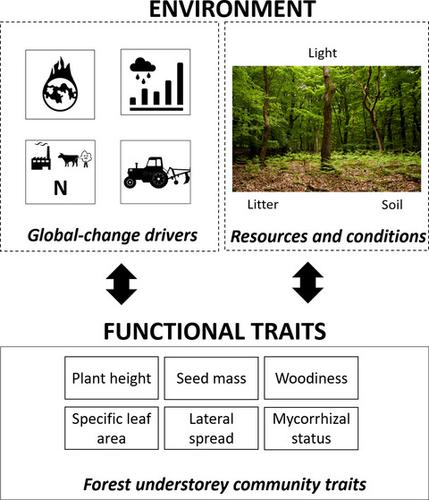当前位置:
X-MOL 学术
›
Plant Biol.
›
论文详情
Our official English website, www.x-mol.net, welcomes your
feedback! (Note: you will need to create a separate account there.)
Plant functional trait response to environmental drivers across European temperate forest understorey communities.
Plant Biology ( IF 4.2 ) Pub Date : 2020-01-12 , DOI: 10.1111/plb.13082 S L Maes 1 , M P Perring 1, 2 , L Depauw 1 , M Bernhardt-Römermann 3 , H Blondeel 1 , G Brūmelis 4 , J Brunet 5 , G Decocq 6 , J den Ouden 7 , S Govaert 1 , W Härdtle 8 , R Hédl 9, 10 , T Heinken 11 , S Heinrichs 12 , L Hertzog 1 , B Jaroszewicz 13 , K Kirby 14 , M Kopecký 9, 15 , D Landuyt 1 , F Máliš 16, 17 , T Vanneste 1 , M Wulf 18 , K Verheyen 1
Plant Biology ( IF 4.2 ) Pub Date : 2020-01-12 , DOI: 10.1111/plb.13082 S L Maes 1 , M P Perring 1, 2 , L Depauw 1 , M Bernhardt-Römermann 3 , H Blondeel 1 , G Brūmelis 4 , J Brunet 5 , G Decocq 6 , J den Ouden 7 , S Govaert 1 , W Härdtle 8 , R Hédl 9, 10 , T Heinken 11 , S Heinrichs 12 , L Hertzog 1 , B Jaroszewicz 13 , K Kirby 14 , M Kopecký 9, 15 , D Landuyt 1 , F Máliš 16, 17 , T Vanneste 1 , M Wulf 18 , K Verheyen 1
Affiliation

|
Functional traits respond to environmental drivers, hence evaluating trait-environment relationships across spatial environmental gradients can help to understand how multiple drivers influence plant communities. Global-change drivers such as changes in atmospheric nitrogen deposition occur worldwide, but affect community trait distributions at the local scale, where resources (e.g. light availability) and conditions (e.g. soil pH) also influence plant communities. We investigate how multiple environmental drivers affect community trait responses related to resource acquisition (plant height, specific leaf area (SLA), woodiness, and mycorrhizal status) and regeneration (seed mass, lateral spread) of European temperate deciduous forest understoreys. We sampled understorey communities and derived trait responses across spatial gradients of global-change drivers (temperature, precipitation, nitrogen deposition, and past land use), while integrating in-situ plot measurements on resources and conditions (soil type, Olsen phosphorus (P), Ellenberg soil moisture, light, litter mass, and litter quality). Among the global-change drivers, mean annual temperature strongly influenced traits related to resource acquisition. Higher temperatures were associated with taller understoreys producing leaves with lower SLA, and a higher proportional cover of woody and obligate mycorrhizal (OM) species. Communities in plots with higher Ellenberg soil moisture content had smaller seeds and lower proportional cover of woody and OM species. Finally, plots with thicker litter layers hosted taller understoreys with larger seeds and a higher proportional cover of OM species. Our findings suggest potential community shifts in temperate forest understoreys with global warming, and highlight the importance of local resources and conditions as well as global-change drivers for community trait variation.
中文翻译:

植物功能性状对欧洲温带森林下层社区环境驱动力的响应。
功能性状响应环境驱动因素,因此评估空间空间梯度上的性状与环境之间的关系可以帮助理解多种驱动因素如何影响植物群落。全球变化的动因,例如大气氮沉积的变化在全球范围内发生,但会影响当地尺度上的群落特征分布,而资源(例如光的可利用性)和条件(例如土壤的pH值)也会影响植物群落。我们调查了多种环境驱动因素如何影响与欧洲温带落叶林林下资源获取(植物高度,比叶面积(SLA),木质度和菌根状态)和再生(种子质量,侧向扩散)有关的社区性状响应。我们对下层社区进行了采样,并得出了全球变化驱动因素(温度,降水,氮沉降和过去土地利用)的空间梯度上的性状响应,同时整合了对资源和条件(土壤类型,奥尔森磷(P))的原位图测量,Ellenberg土壤湿度,光,垫料质量和垫料质量)。在全球变化驱动因素中,年平均气温强烈影响与资源获取有关的性状。较高的温度与较高的下层相关,从而产生具有较低的SLA和较高比例的木质和专性菌根(OM)菌种的叶子。Ellenberg土壤水分含量较高的样地社区的种子较小,木质和OM物种的比例覆盖率较低。最后,垫料层较厚的地块具有较高的下层种子,较高的覆盖率和较高的OM物种覆盖率。我们的发现表明,随着全球变暖,温带森林下层可能发生社区转移,并强调了当地资源和条件以及全球变化对社区特征变化的驱动力的重要性。
更新日期:2020-01-12
中文翻译:

植物功能性状对欧洲温带森林下层社区环境驱动力的响应。
功能性状响应环境驱动因素,因此评估空间空间梯度上的性状与环境之间的关系可以帮助理解多种驱动因素如何影响植物群落。全球变化的动因,例如大气氮沉积的变化在全球范围内发生,但会影响当地尺度上的群落特征分布,而资源(例如光的可利用性)和条件(例如土壤的pH值)也会影响植物群落。我们调查了多种环境驱动因素如何影响与欧洲温带落叶林林下资源获取(植物高度,比叶面积(SLA),木质度和菌根状态)和再生(种子质量,侧向扩散)有关的社区性状响应。我们对下层社区进行了采样,并得出了全球变化驱动因素(温度,降水,氮沉降和过去土地利用)的空间梯度上的性状响应,同时整合了对资源和条件(土壤类型,奥尔森磷(P))的原位图测量,Ellenberg土壤湿度,光,垫料质量和垫料质量)。在全球变化驱动因素中,年平均气温强烈影响与资源获取有关的性状。较高的温度与较高的下层相关,从而产生具有较低的SLA和较高比例的木质和专性菌根(OM)菌种的叶子。Ellenberg土壤水分含量较高的样地社区的种子较小,木质和OM物种的比例覆盖率较低。最后,垫料层较厚的地块具有较高的下层种子,较高的覆盖率和较高的OM物种覆盖率。我们的发现表明,随着全球变暖,温带森林下层可能发生社区转移,并强调了当地资源和条件以及全球变化对社区特征变化的驱动力的重要性。











































 京公网安备 11010802027423号
京公网安备 11010802027423号